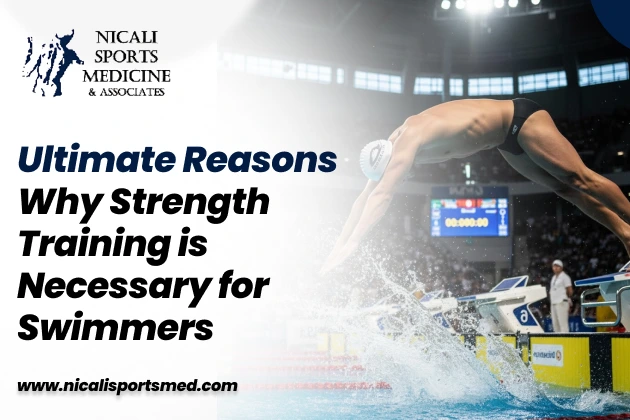Swimming is one of the toughest sports out there, working your body from head to toe while challenging your stamina, technique, speed, flexibility, and concentration. Technique is important, sure, but what really separates good swimmers from great ones is strength training.
Adding strength work gives your body the power and stability it needs to cut through the water efficiently. Unlike air, water resists every movement, so strong muscles and joints make every stroke count. Whether you’re racing competitively, training for a triathlon, or just swimming for fun, strength training is the secret weapon that takes your performance to the next level.
Let’s explore the blog and find out how adding strength training to your routine can help you swim faster and more efficiently.
Understanding the Physical Demands of Swimming
We all know that strength matters in swimming. Stronger muscles not only improve your kicks and stroke power but also enhance your overall performance, from the very start to the final touch.
This all sounds great, right? But here’s the exciting part: strength training offers benefits beyond just building muscle. According to the National Institute of Health, an article published in the Journal of Strength and Conditioning Research, swimmers who include strength work in their routine see significant improvements in stroke efficiency and power compared to those who only spend time in the pool.
Simply put, the stronger your muscles, the more force you can push against the water. That means faster swim times, less fatigue, and more energy to maintain your technique throughout the race.
Key Strength Training Movements for Swimmers
Swimmers don’t need to lift heavy weights like bodybuilders. What really matters are exercises that make your body stronger, more stable, and better at moving through the water.
To swim stronger and faster, your workouts should target the muscles you actually use in the pool. Here are some of the most effective exercises for swimmers:
- Pull-ups and lat pulldowns – These moves build a strong back and give your strokes more power, helping you cut through the water effortlessly.
- Planks and rotational core work – A strong core keeps your body stable and aligned, reducing drag and improving efficiency with every stroke.
- Squats and lunges – Your legs are more than just kickers. Squats and lunges strengthen them to deliver explosive propulsion and maintain speed.
- Shoulder stabilizing exercises(like external rotations) – Prevent common swimming injuries by keeping your shoulders strong and balanced.
- Medicine ball throws – Perfect for explosive power off the walls, starts, and turns, helping you gain precious milliseconds in every race.
By focusing on these targeted moves, you’re not just lifting weights; you’re training your body to move smarter, faster, and more efficiently in the water.
How Strength Training Enhances Swimming Performance
Strength training gives swimmers the physical support they need to really move with power in the water. Pool workouts are great for building technique and stamina, but muscles need to be strong enough to back up those skills. When swimmers work on their strength outside the pool, they stay more stable in the water, and they don’t tire out as quickly.
So, let’s look at what strength training does for swimmers:
1. More Power and Speed
Strong muscles drive every stroke and kick. A powerful upper body improves your pull, strong legs boost your kick, and a solid core keeps your body steady and transfers power efficiently.
2. Better Efficiency and Stamina
Technique alone isn’t enough; your muscles need to support it. Strength work helps you stay aligned, move smoothly, and reduce drag, while also allowing your muscles to last longer during long swims. This means you maintain speed without tiring out too quickly.
3. Lower Risk of Injury
Swimmers often deal with shoulder, back, and knee strain from repetitive movements. Strength training balances and strengthens key muscles, improves posture, and protects joints, helping prevent overuse injuries and keeping you in the water longer.
Upper and Lower Body Strength: Powering Every Stroke and Kick
Strong arms, shoulders, and back muscles are essential for a powerful pull through the water. Your upper body drives your strokes, helping you cut through the water faster while maintaining proper form. Without this strength, even the best technique can fall short.
Equally important is lower-body strength. Powerful legs fuel your kicks, giving you extra propulsion and helping maintain balance in the water. A strong core connects your upper and lower body, ensuring that every stroke and kick works together efficiently.
By targeting both upper and lower body muscles, swimmers can maximize speed, improve endurance, and reduce the risk of injuries caused by overcompensation or fatigue. Strength training isn’t just about lifting weights; it’s about building a body that moves confidently and efficiently through the water.
A Legal and Scientific Note on Safe Strength Training
Under the guidelines of the National Strength and Conditioning Association (NSCA), strength training for youth and athletes should follow proper progression and supervision. It is essential to warm up correctly, use proper form, and avoid overtraining.
These practices help prevent strain injuries and ensure long-term performance improvement. No athlete benefits from sacrificing technique and joint health for immediate results.
How Recovery Boosts Swimming Performance
Hard training in the pool is only half the battle; recovery is just as important. Skipping it can lead to sore muscles and slow down progress. A full deep tissue massage helps release tension, boost blood flow, and improve flexibility, keeping your body ready for the next session.
Professional care from the best chiropractor Pasadena also plays a key role. Chiropractic care keeps your spine aligned and shoulders mobile and letting your body move as one seamless unit. The result? You swim stronger, glide smoother, and feel more comfortable in the water.
Finish Strong: The Role of Strength in Your Swim
Strength training is more than just building muscles; it’s what helps you move efficiently, stay resilient, and reach new levels in your performance.
By developing power, improving endurance, and protecting your body from injury, you give yourself the edge to swim faster and feel more confident in the water. Pairing focused training with proper recovery ensures you stay consistent and energized, session after session.
When technique, strength, and smart preparation come together, you don’t just swim, you perform at your very best. Every stroke, every kick, and every turn counts toward unlocking your full potential.

